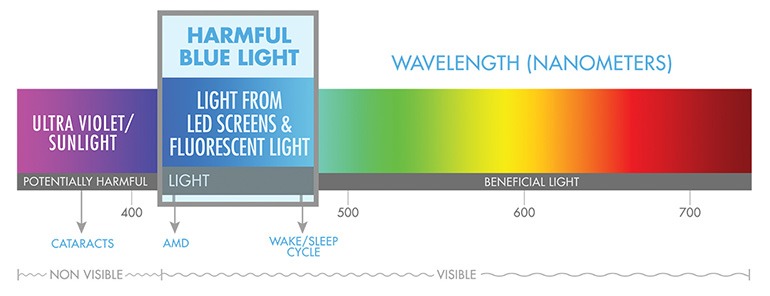Blue light


Most of you would have heard about the “damaging blue light” emitted from your digital devices or tried the “night mode” on your phone or tablet. This article discusses the what blue light is, the beneficial and harmful effects of it and ways that you can limit the blue light getting to your eyes.
THE SCIENCE:
Blue light is part of the visible light spectrum (a.k.a. electromagnetic spectrum), along with red, green, yellow etc (unlike infrared, UV, microwaves that we cannot see). The distinction of colour depends on the wavelength of the light, with blue light having very short wavelengths and high energy and red light having long wavelengths and low energy. Ultraviolet rays (with an even shorter wavelength than blue/violet light – i.e. beyond violet) has more energy than visible light – hence why it can lead to sunburn and cancer. Blue light comprises of about a third of visible light (Blue-violet light 380-450nm, blue-turquoise light 450-500nm) so it is found everywhere – natural sunlight, laptops, computers, TVs, tablets, mobile phones, fluorescent and LED lighting.

BLUE LIGHT AND THE EYES:
It is harder to bring blue light into focus than other visible light because of the degree that blue light scatters. This can cause the eyes to become strained and fatigued if you are on digital devices.
The amount of time spent on screens has increased significantly in recent times so patients that never would have needed glasses are now needing them to help relieve their eyestrain, headaches, glare or improve sleeping patterns.
We don’t know the long term effect that all of this blue light has on the macula as we do not have longitudinal evidence yet. However, studies suggest continued blue light exposure could damage the retinal cells over time, and thus result in increasing one’s risk of macular degeneration.
BLUE LIGHT IS NOT ALL BAD:
As with almost everything, blue light is good for you in moderation. Blue light has been well documented to boost alertness, elevate moods, help with memory and cognitive function as well as regulate a healthy circadian rhythm. However, too much blue light at night can disrupt the cycle making it harder to get to sleep after screen time.
WHAT CAN YOU DO TO LIMIT THE AMOUNT OF BLUE LIGHT GETTING TO YOUR EYES
Screens:
Try to limit the amount of time spent on screens and take regular breaks when you do. Follow the 20/20/20 rule – every 20 minutes, look 20 feet away from your screen for at least 20 seconds.
A lot of digital devices now have blue light filters (“night mode”) that make your screen turn slightly yellow. This actually reduces the blue light emitted and is especially ideal to use at night-time so that your sleeping pattern is not disrupted.
Glasses:
Prescription computer glasses can help relieve some of the strain your eyes experience when doing near work by relaxing them. We can also add a blue light blocker coating that reflects away the blue light limiting the amount getting to your eyes. This coating will make things appear slightly yellower.
Some people use amber coloured glasses but it generally isn’t very practical due to the cosmetic appearance of them when in public.







